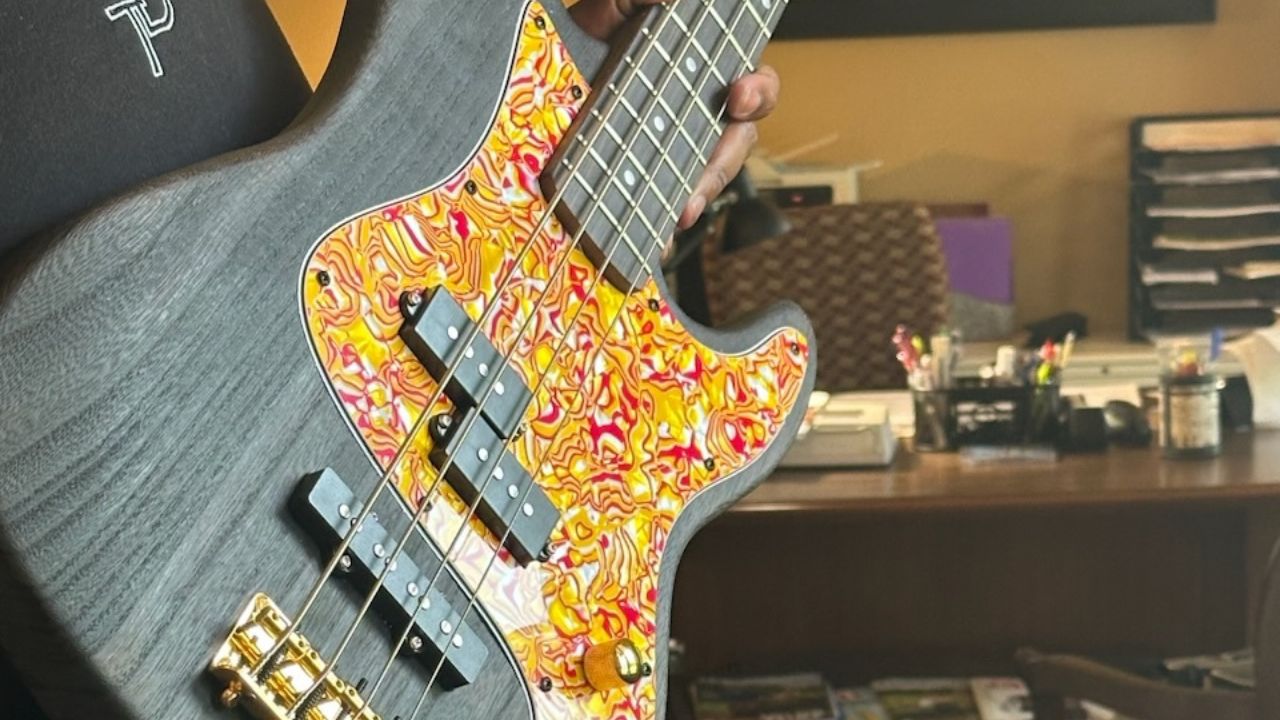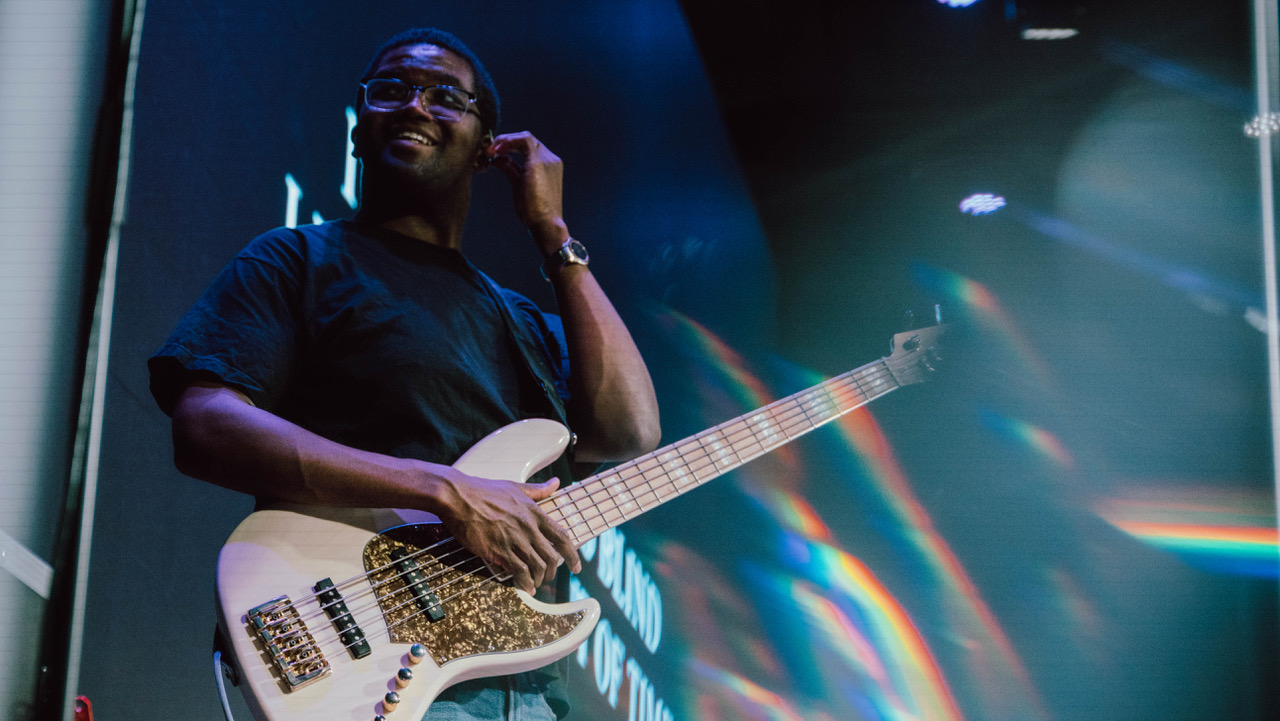“We didn’t have time to paint it, so we used a blowtorch. We thought it was going to catch on fire”: Nashville session bassist Travis Dykes spent $136 building a bass from Temu parts. Now he’s playing it on some seriously big gigs
From legendary Nashville sessions to performing on the world's biggest stages, Travis Dykes charts the surprise success of the budget bass he built in a day

Not just a bass player, but a YouTuber with a whopping 23,162,126 views in less than 350 videos, Travis Dykes’ social media is directed at bass players in search of gear, theory insights, music history or just some lighthearted entertainment.
For his most intriguing project, the Nashville-based session player teamed up with online marketplace Temu and embarked on a DIY bass build that saw him craft his own 4-string bass guitar from scratch using parts sourced only from the Chinese e-commerce company.
“At first Temu only stocked some effects pedals,” says Dykes. “But as their inventory grew, I realised I could buy enough parts to build a bass. I had no expectations of the bass being playable, but I thought it would make a dope video for the YouTube channel.”
As you might expect, there’s more to building a bass than merely sourcing the parts, and having some know-how with a screwdriver.
“I have a friend who’s a guitar builder, and so we decided to build it together. The only real issue we had was with the finish. We didn’t have time to paint it, so we used a blowtorch to make the body look a little different. At one point we thought it was going to catch on fire!”
Will the Temu bass ever be accepted by established players, we wonder? Perhaps when people get over their prejudices, Dykes explains: “The first time I pulled it out at a gig people were like, ‘What is that?’ I think it was a visual thing because they immediately clocked that I was playing a gnarly-looking bass, but I played it through a good DI pedal, so the sound was actually pretty good.

“I’ve used it on some big gigs, and I’ve had other people try it. Bass players really like the tone and the playability. It doesn’t even have a name on the headstock, but I still get messages from people wanting to buy it. It's not for sale!”
All the latest guitar news, interviews, lessons, reviews, deals and more, direct to your inbox!
Do you think people’s mentality towards bass gear has changed?
“If someone pulls out a high-end bass guitar at a gig, I’d expect them to be a serious bass player, but then I might see someone playing a Fender Squier and immediately think they’re legit. So the playing field has definitely evened out. Everything seems a lot more subjective.”
How did you get started when you first moved to Nashville?
“I started out playing country gigs, and I found it really boring! I remember there was a Blake Shelton song I had to learn for some bar gig, and the bass player played this awesome substitution. That’s when I realized that you can still play in the pocket and make it fun. Just because the chord structure is pretty simple, it doesn’t have to be boring.”
Your early YouTube videos were essentially bass lessons. Why did you evolve them into the more entertaining pieces they are now?
“I still wanted to make videos that were educational, but I got to a point where I wanted to create content that was more captivating. Even when we built the bass using Temu parts, I wanted to educate people about the process, so they could learn about different wood types and different pickups.”
How did people react when you started reviewing gear?
“There were times when I’d get the terminology wrong, and then I’d get flooded with comments from people who’d immediately think I was an idiot!
“I had to learn about neck-through-body basses, and how different bridges are put together, the whole active vs passive debate, and all the other technical jargon. So these bass builds have been a real learning curve for me as well. I really had to start doing my research.”
Do you prefer active or passive basses?
“I grew up playing gospel music, so active basses were always my go-to when it comes to bass tone, but I do think it's subjective to the player. Some people swear by P-Basses, but I like the brighter tone you can get with a battery. My go-to bass right now is a 5-string Jazz Bass from a company called Bassmods.”
Do you play 4-string or a 5-string?
“I used to be a 6-string player, but I only jumped on that train because everybody in gospel was playing a 6-string Ken Smith at the time.
“When you’re playing gospel music there are often a lot of sharp and flat key signatures to deal with, and with a 5-string bass you can hit E flat, and D flat, and you have a low B. You have even more options if you tune down. So a 5-string is like the medium ground for me. You can only go so far with a 4-string.”
Is there still a market for boutique builders?
“There’s still an audience that wants to spend money on a high-end bass guitars, but you also have the players who just need something to take on the road. For builders, I guess it’s about finding the audience that they’re really interested in.”
What are your thoughts on custom builds?
“I know they can be a source of frustration for builders! I’m sure they’ll know in the back of their mind if what the customer is asking for is a good idea or not, but they often have to go down that road anyway.
“My first bass build video got more than half a million views, but some people hated me for it because I added an active circuit to a P-Bass! I really had to go back and educate myself on the history of the P-Bass. But that’s why making videos and posting on social media is so important for musicians. It’s a really good way to challenge yourself.”
How do you handle unpleasant comments online?
“I know some YouTubers who read through the comments section every day. I’m at around 215,000 subscribers, and it’s becoming really hard to keep up.
“If the feedback is encouraging or constructive then I might dig into it, but I still try to view my YouTube subscribers as customers. If you don’t listen to their feedback, then it’s going to be really hard to make content they want to see.
“Some people will like what you do, and some won’t. And the bigger the stage, the more diverse that audience becomes.”
Do you get more recognised now because of your YouTube persona?
“That was something I struggled with when I first started to gain some traction on YouTube. It’s the reason why Instagram musicians have to make sure they can actually play live, and not just in studio conditions.
“Whenever I go out and play, I'm just trying to play the gig. I’m not trying to bust out any Instagram licks! But there was a time when I'd start to see fans of the channel showing up, and I’d suddenly feel the pressure of knowing that they’re expecting me to play out a little more. But even if know there’s a fan of my channel in the audience, I'm just going to play what I'm supposed to play.”

Do you use any effects pedals?
“In the gospel world, you have to have a good bass, a good bass amp, and the rest is in your hands! So I didn't grow up using a lot of effects pedals.
“I can remember when we all thought synth basses were going to take over the world! But I think people still want to hear that human feel. So I think pedals are still very relevant.
“Just look at someone like MonoNeon. Whenever he steps on a pitch-shifter and just goes crazy with it, you can still hear the imperfections, and that’s where the humanity comes through.”
What’s been the main benefit of being a YouTuber?
“Instagram and YouTube have both opened doors for me that probably wouldn't have been open otherwise. In fact, some artists will reach out to me directly via Instagram having accidentally found the channel.
“But with any platform like Instagram, there’s always a danger that someone will just look at the numbers. They’ll hire someone based on their subscriber count, without knowing if they can actually play!
“Other times, the subscriber count can be too intimidating for an artist to get in touch. They might even assume they can’t afford me!
“I’ve also had the inverse of that where somebody’s gone out to hire a whole bunch of popular social media musicians for their band. That's when you have to ask yourself if they’re out to make music or to make content.”
What advice would you give someone who's just starting out?
“Strive to be a musician first. If I’m on a gig, I always want the artist to know that their music is the most important thing to me.”

Nick Wells was the Editor of Bass Guitar magazine from 2009 to 2011, before making strides into the world of Artist Relations with Sheldon Dingwall and Dingwall Guitars. He's also the producer of bass-centric documentaries, Walking the Changes and Beneath the Bassline, as well as Production Manager and Artist Liaison for ScottsBassLessons. In his free time, you'll find him jumping around his bedroom to Kool & The Gang while hammering the life out of his P-Bass.
You must confirm your public display name before commenting
Please logout and then login again, you will then be prompted to enter your display name.




